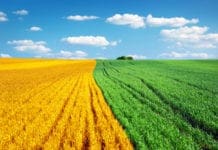The creation of the food and nourishment required by all creatures to sustain life took twice as long as that required for the creation of the earth. The length of time indicates how vast the task must have been.
“He placed on the (earth) mountains that stand firm and high above it. He blessed the earth and measured all things therein so that they would receive their nourishment in due proportion, in four days, according to (the needs of) those who seek (sustenance).” (Surah Fussilat, 41:10)
Plants are the most successful forms of life. There are some 350,000 different species ranging from the very large (e.g., forest trees) to the very small (e.g., moss, mold, and bacteria). They are found in almost every part of the world, even in freezing tundra, hot springs, or at high altitudes. Almost all are self-sufficient and can make their own food from elementary materials extracted from the air and the soil. Without them, animals and man could not exist, for plants replenish the planet’s oxygen stores and offer themselves as food for many creatures.
God created the rivers and made each type of fruit in pairs, which gives evidence of reproduction. He describes the various types of plants, vines, palms, and others; states that they are all different, even though they are all irrigated with the same water, (Surah Ar-Ra’d,13:3-4); and invites man to study their differences. They are all made out of water(Surah Al-Anbiya’, 21:30), for God made all forms of life out of water, and then are irrigated with the same water. This raises a question: What factors decide the differences in their appearance and taste?
In fact, He was asking man to study the plant kingdom. Genetic studies of plants is far easier to conduct than those involved with animals and man. Early Mendelian laws of genetics were studied in plants and later extended to man. Researching plants involves no risk and is relatively inexpensive. It is also easy to reproduce the results, as the short life span of some plants makes it possible to study several generations in a short period of time.
“God spread out the earth, set on it firm mountains and flowing rivers. He made all kinds of fruit in two pairs, two and two. He draws the night as a veil over the day. Truly, in these things are signs for those who consider. In the earth are neighboring (but diverse) tracts, gardens of vines, fields sown with com, and palm trees growing out of single roots or otherwise, watered with the same water, yet some of them We make more excellent to eat than others. Truly in these things are signs for those who understand.” (Surah Ar-Ra’d, 13:3-4)
“Do the unbelievers not see that the heavens and the earth were joined together (as one unit of creation) before we caused them to separate? We made every living thing from water. Will they still not believe?” (Surah Al-Anbiya’, 21 :30)
Not only did God say that He made all plants from pairs, but He also explained how He causes some of them to reproduce by air-borne fertilization. He commands the wind to carry pollen to plants that otherwise could not reproduce. It is now well known that this is the only way to fertilize several plants. Some plants, such as conifers, generally use the wind rather than insects for pollination purposes.
“We send the fertilizing winds and then cause rain to fall from the sky, thereby providing you with (abundant) water, although you are not the guardians of its stores.” (15:22)
(with slight changes)












